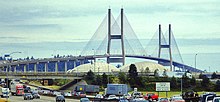Alex Fraser Bridge
| Alex Fraser Bridge | |
|---|---|

Alex Fraser Bridge, looking southbound from Annacis Island.
|
|
| Coordinates | 49°09′35″N 122°56′34″W / 49.1598°N 122.9428°WCoordinates: 49°09′35″N 122°56′34″W / 49.1598°N 122.9428°W |
| Carries | Six lanes of British Columbia Highway 91, pedestrians and bicycles |
| Crosses | South Arm Fraser River |
| Locale | Delta, BC |
| Maintained by | British Columbia Ministry of Transportation |
| Characteristics | |
| Design | cable-stayed bridge |
| Material | Steel & Reinforced concrete |
| Total length | 2,525 m (8,284 ft) |
| Width | 32 m (105 ft) |
| Height | 154 m (505 ft) |
| Longest span | 465 m (1,526 ft) |
| Clearance below | 55 m (180 ft) |
| History | |
| Designer | Buckland & Taylor |
| Construction start | 1983 |
| Opened | September 22, 1986 |
| References | |
The Alex Fraser Bridge (also known as the Annacis Bridge) is a cable-stayed bridge over the Fraser River that connects Richmond and New Westminster with North Delta in Greater Vancouver, British Columbia. The bridge is named for Alex Fraser (1916 – 1989), a former British Columbia Minister of Transportation.
The bridge was the longest cable-stayed bridge in the world when it opened on September 22, 1986 and was the longest in North America until the Arthur Ravenel Jr. Bridge opened in 2005. As of 2009 it is the 32nd-longest cable-stayed bridge in the world, and second-longest in North America. It is 2,525 m (8,284 ft) long with a main span of 465 m (1,526 ft). The towers are 154 m (505 ft) tall. It consists of six lanes, three in each direction, and has a maximum speed limit of 90 km per hour. Upon opening in 1986, only four of the six available lanes were open. Cyclists and pedestrians share two narrow side-walks one on each side. All six lanes opened in 1987 after traffic demand justified the need.
The bridge's southern end is in North Delta and its northern end is on Delta's Annacis Island. Connections on its southern end lead to Blaine, Washington and to White Rock. The connections on the northern end lead into the cities of New Westminster, Richmond, and Burnaby, and on into Vancouver itself. It is a major artery in the Lower Mainland of British Columbia.
The bridge was constructed for the British Columbia Ministry of Transportation and was designed by a joint venture of Klohn Crippen Berger and Buckland & Taylor (Now COWI North America). Its total cost was $58 million.
...
Wikipedia
